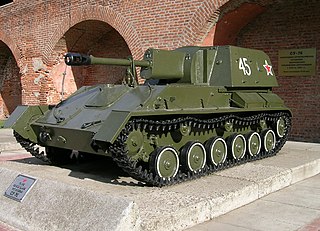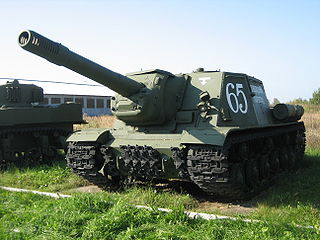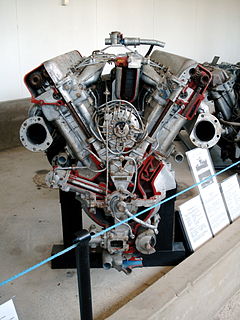
The IS Tank was a series of heavy tanks developed as a successor to the KV-series by the Soviet Union during World War II. The IS acronym is the anglicized initialism of Joseph Stalin. The heavy tanks were designed with thick armor to counter German 88 mm guns and carried a main gun capable of defeating Panzer IV tanks. They were mainly designed as breakthrough tanks, firing a heavy high-explosive shell that was useful against entrenchments and bunkers. The IS-2 went into service in April 1944 and was used as a spearhead by the Red Army in the final stage of the Battle of Berlin. The IS-3 served on the Chinese-Soviet border, the Hungarian Revolution, the Prague Spring and on both sides of the Six-Day War. The series eventually culminated in the T-10 heavy tank.

The Kliment Voroshilov (KV) tanks are a series of Soviet heavy tanks named after the Soviet defence commissar and politician Kliment Voroshilov which operated with the Red Army during World War II. The KV tanks were known for their heavy armour protection during the early stages of the war, especially during the first year of the German invasion of the Soviet Union. In certain situations, even a single KV-1 or KV-2 supported by infantry could halt German formations. The German Wehrmacht at that time rarely deployed its tanks against KVs, as their own armament was too poor to deal with the "Russischer Koloss" – "Russian Colossus".

Soviet combat vehicle production during World War II from the start of the German invasion of the Soviet Union on 22 June 1941 was large. Although the Soviet Union had a large force of combat vehicles before the German invasion, heavy losses led to a high demand for new vehicles. Production was complicated by the loss of production facilities in the western part of the Soviet Union, and entire factories were moved east of the Ural Mountains to put them out of reach of the Germans. In general, Soviet tanks had less interior space than the tanks of other nations - this was possible because the Red Army only employed soldiers of small stature in their tank forces.

The SU-76 was a Soviet light self-propelled gun used during and after World War II. The SU-76 was based on a lengthened version of the T-70 light tank chassis and armed with the 76 mm divisional gun M1942 (ZiS-3). Its quite simple construction and multipurpose combat role made it the second most produced Soviet armoured fighting vehicle of World War II, after the T-34 medium tank.

The SU-122 was a Soviet self-propelled howitzer or assault gun used during World War II. The number "122" in the designation represents the caliber of the main armament—a 122 mm M-30S howitzer. The chassis was that of the T-34.

The SU-85 was a Soviet self-propelled gun used during World War II, based on the chassis of the T-34 medium tank. Earlier Soviet self-propelled guns were meant to serve as either assault guns, such as the SU-122, or as tank destroyers; the SU-85 fell into the latter category. The designation "85" means the bore of the vehicle's armament, the 85 mm D-5S gun.

The ISU-122 was a Soviet assault gun used during World War II, mostly in the anti-tank role.

The ISU-152 is a Soviet self-propelled gun developed and used during World War II. It was unofficially nicknamed zveroboy in response to several large German tanks and guns coming into service, including Tigers and Panthers. Since the ISU-152's gun was mounted in a casemate, aiming it was awkward, and had to be done by repositioning the entire vehicle using the tracks. Therefore, it was used as mobile artillery to support more mobile infantry and armor attacks. It continued service into the 1970s and was used in several campaigns and countries.

Parola Tank Museum, officially Armoured Vehicle Museum is a military museum located 110 kilometres north of Helsinki in Parola, near Hämeenlinna, Finland, a few kilometres from the Finnish Army Armoured Brigade training unit. It displays various tanks, armoured vehicles and anti-tank guns used by the Finnish Defence Forces throughout their history, including their latest Leopard 2A4 tank. A rare exhibit is an armoured train used in World War II. The museum was opened on June 18, 1961, when there were 19 tanks and 12 anti-tank guns on display.
Samohodnaya Ustanovka may refer to any of these Soviet casemate self-propelled guns:

ZSU-37 was a Soviet-made, light, self-propelled anti-aircraft gun (SPAAG), developed by the end of 1943 and produced at Works No. 40 in Mytishchi. It was the first Soviet series-produced tracked SPAAG. ZSU stands for Zenitnaya Samokhodnaya Ustanovka, meaning "anti-aircraft self-propelled mount".

The Military Technical Museum Lešany is a museum of military vehicles located in the Czech Republic, about 20 kilometers south of Prague. Its exposition contains over 700 historic tanks, cannons, motorcycles, armored vehicles, trucks, military passenger vehicles, missile systems and other military equipment manufactured from 1890 to the present.

The Kharkiv model V-2 was a Soviet diesel tank V-12 engine designed at the Kharkiv Locomotive Factory by Konstantin Chelpan and his team. It is found in the BT-7M (BT-8), T-34, KV, IS and IS-10 (T-10) tanks, and by extension, the vehicles based on them, such as the SU-85 and SU-100 tank destroyers based on the T-34 and the ISU-122 and ISU-152 self-propelled guns based on the IS-2. Throughout its production life, output ranged from roughly 450-700 hp. The water-cooled engine was made of aluminium.

The IS-2 is a Soviet heavy tank, the first of the IS tank series named after the Soviet leader Joseph Stalin It was developed and saw combat during World War II, and saw service in other Soviet allied countries after the war.
















